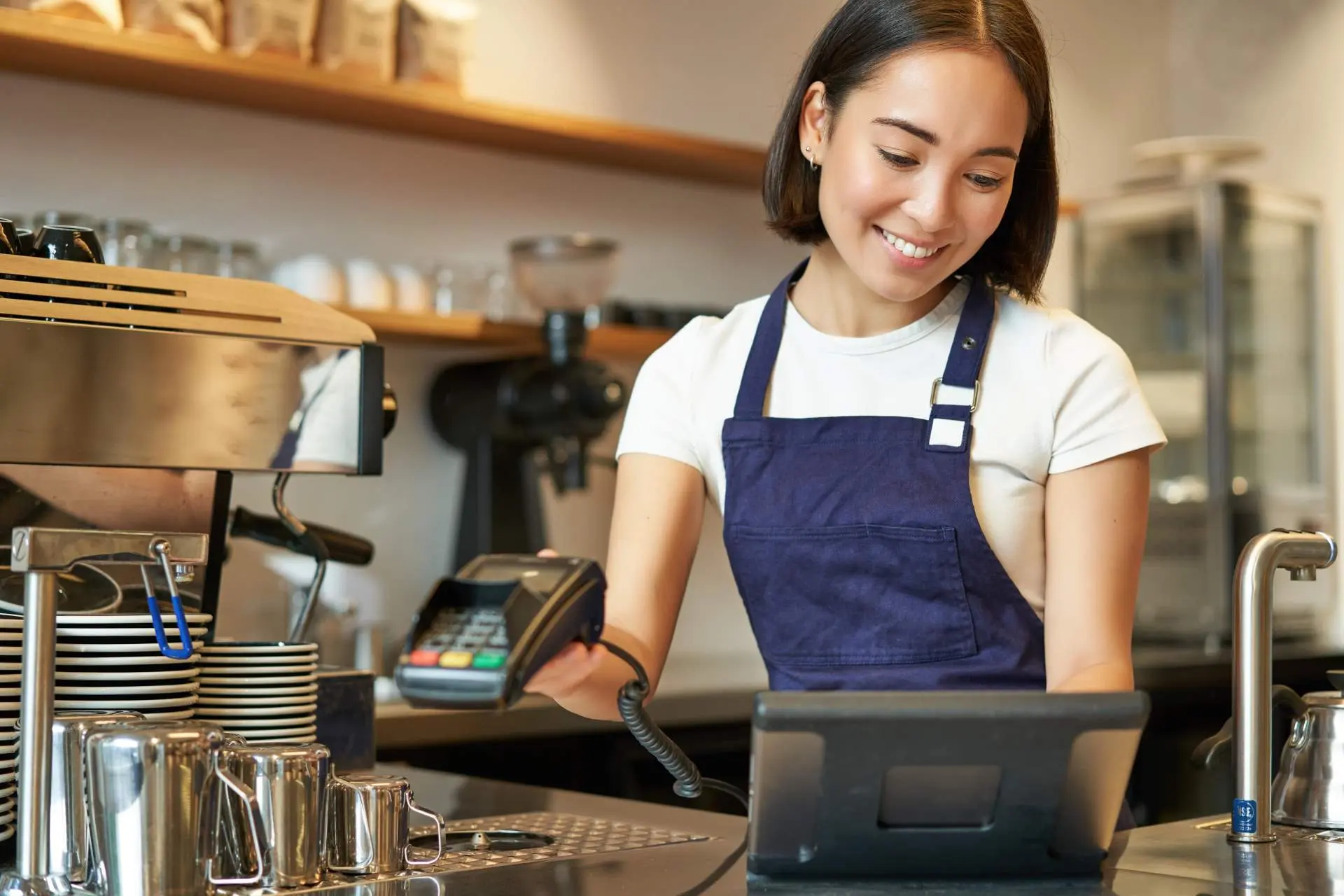The efficiency of your workplace is important if you own or manage a restaurant. As the famous chef Wolfgang Puck once said: “A lot of restaurants serve good food, but they don’t have very good service.”
This is why running a successful restaurant business requires seamless operations, and one key ingredient for this recipe is a reliable restaurant point-of-sale (POS) system.
This article will provide you with essential information about choosing POS systems for restaurants. But before you get started with any system, don’t forget to make sure your staff know how to use it – otherwise, you might end up with a lot of “under or over-cooked orders”!
What is a restaurant POS system?
A restaurant POS (Point of Sale) system is a combination of hardware and software designed specifically for the unique needs of the food service industry. It serves as the central hub for managing various aspects of restaurant operations, including inventory management, menu customisation, guest tracking, floor management, and built-in CRM systems for upselling and cross-selling opportunities.
Key features of a restaurant POS system
A robust restaurant POS system offers a wide range of features that help streamline operations and enhance customer service. Some key features include:
Inventory management
Keep track of stock levels, automate reordering, and minimise waste.
Menu management
Keep track of stock levels, automate reordering, and minimise waste.
Guest tracking
Maintain customer profiles, track preferences, and provide personalised experiences.
Floor management
Efficiently manage table assignments, seating arrangements, and waiting lists.
Built-in CRM systems
Utilize customer data to offer targeted promotions and loyalty programs and improve customer satisfaction.
On-site or cloud-based?
Restaurant POS systems can be categorised as either on-site or cloud-based. On-site systems are installed on local servers and devices within your restaurant, while cloud-based systems are hosted on the Internet and are accessible from any device with an Internet connection.
Cloud-based systems offer the advantage of accessibility, data backup, and seamless updates, whereas on-site systems provide more control over data security and customisation options.
How we enabled cloud-based POS for Hospitality Digital Services
Hardware components of a POS system
A restaurant POS system requires various hardware components to effectively manage operations and process transactions. Here the essential hardware components commonly found in a restaurant POS system:
Terminals
These are the primary devices used by restaurant staff to enter orders, process payments, and perform various functions. Terminals typically consist of a screen, keyboard, and a built-in or attached card reader. Restaurants can also use virtual terminals to accept payments over the phone.
Tablets
They provide mobility and flexibility for order-taking and payment processing. They allow servers to take orders directly at the table, send them to the kitchen, and accept payments on the spot. Tablets can also be used for other tasks like displaying menus and processing loyalty programs.
Kiosks
Self-service kiosks are becoming increasingly popular in restaurants. Customers can use them to place their orders and make payments without the need for staff assistance. Kiosks streamline the ordering process, reduce wait times, and provide a convenient option for customers who prefer self-service.
Kitchen displays
These displays are installed in the kitchen area and show incoming orders to the kitchen staff. They provide clear instructions and help manage order preparation efficiently. Kitchen displays are essential for improving order accuracy and reducing wait times.
EMV Readers (Europay, Mastercard, and Visa)
These readers are used to process chip-enabled credit and debit cards. These readers ensure secure transactions and are essential for complying with industry standards and reducing the risk of fraud.
Cash drawers
Cash drawers securely store cash and coins received from customers. They are typically connected to the terminal or tablet and can be opened after successful payment. Cash drawers often have locking mechanisms to ensure cash handling security.
Receipt printers
These generate physical receipts for customers after successful payment. They provide a physical record of the transaction and can also be used for ordering tickets in the kitchen. Receipt printers come in various types, such as thermal printers or impact printers.
Benefits of a restaurant POS system
Restaurants have unique operational needs compared to other businesses, and a well-implemented POS system can provide numerous benefits. Here are some advantages of using a restaurant POS system:
Improve customer service
Reduce wait times, minimise errors in orders, and streamline payment processes for enhanced customer satisfaction.
Increase sales and profitability
Optimise menu pricing and promotions and utilise upselling opportunities to drive revenue.
Streamline operations
Automate order taking, inventory tracking, and staff scheduling and generate insightful reports for data-driven decision-making.
Enhance data security and compliance
Protect customer data through encryption, adhere to industry standards, and ensure secure transactions.
Grow your business
Integrate with online ordering, delivery, loyalty, and marketing platforms to expand your customer base.
Optimising the checkout process for credit card payments
A seamless and user-friendly checkout experience reduces friction and increases conversion rates. Ensuring a responsive design and mobile optimisation for your checkout process facilitates seamless payment processing on various devices.
To significantly reduce cart abandonment rates, businesses can:
- Simplifying the checkout flow
- Minimise the number of form fields
- Offer guest checkout options
- Implement trusted payment options such as digital wallets and alternative payment methods to cater to customer preferences.
How to Choose a Restaurant POS system
Here are three factors to keep in mind during the selection process:
Budget and pricing
Compare upfront and ongoing costs, including hardware, software, installation, maintenance, and support fees. Look for transparent and flexible pricing plans that align with your cash flow.
Restaurant size
Ensure the system can handle your transaction volume, number of locations, menu complexity, and service style.
Desired features
Identify the essential functions and integrations you require, such as inventory management, table management, online ordering, and loyalty programs. Look for systems that offer these features or can integrate with third-party solutions.
Working with Trust Payments as your restaurant POS provider
We are the leading provider of hospitality payment solutions, making payments purpose-built for busy hospitality businesses.
Our TRU POS offers a seamless and fully-supported payments system that:
- Accepts all major payment methods: credit cards, debit cards, mobile wallets, and online payments.
- Offers secure and reliable processing with advanced fraud prevention tools, PCI compliance, and 24/7 support for seamless transactions.
- Offers competitive rates, transparent fees, and easy integration with your existing or preferred restaurant POS system.
- Shows you real-time data and insights – valuable information on payment performance, customer behaviour, and market trends for informed decision-making.
Conclusion
A restaurant POS system is an invaluable asset for optimising your restaurant business. It empowers you to enhance customer service, increase sales, streamline operations, and drive growth. When selecting a restaurant POS system, consider your specific needs, and explore us as a reliable partner to support your business growth.
Contact Us today to elevate your restaurant business with our payment solutions. Take the next step towards achieving operational excellence and delivering exceptional dining experiences to your customers.





